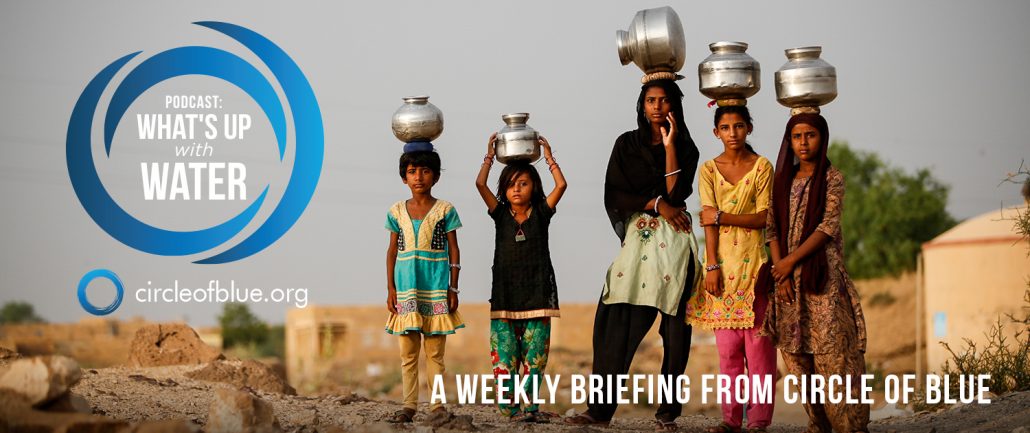
Transcripts
What’s Up With Water for March 12, 2018 I’m Eileen Wray-McCann, for Circle of Blue, and here’s What’s up with Water, a condensation of the world’s water news.
Farmers in northwest Kansas finished a five-year experiment to save groundwater, and their way of life. Some 60 farmers in Sheridan County agreed that pumping massive amounts from the Ogallala Aquifer was not sustainable. The aquifer is one of the nation’s vital sources of irrigation, and it is being drawn down far faster than it can recover. The farmers used a conservation agreement to mandate a 20% cut in their water withdrawals from 2012 to 2017. Their goal: to prove that they could adapt, thrive, and preserve water for future generations to farm. Recent analysis by Kansas State University and the Kansas Geological Survey found that the farmers had succeeded. The five years of restrictions in Sheridan County had a significant benefit to the aquifer. Although the groundwater levels continued to recede, the rate of decline in the county dropped by two thirds. Farmers cut water use without harming profitability – in some cases, the efforts raised their earnings. They made more astute water choices by studying forecasts, using moisture probes, and selecting water-saving crops. More farmers in Kansas are signing on to the conservation effort, which could be a model for stabilizing the Ogallala Aquifer for the next 20 years. Experts warn, however, that the effects of climate change on temperature and precipitation make predictions beyond that uncertain. Circle of Blue’s Brett Walton has more about the Kansas farming project at circleofblue.org.
In a related story, altered farming practices and other measures aided the return of seagrass to the Chesapeake Bay. Scientific results published last week show that in the last 30 years, seagrass expanded significantly since farmers in Maryland, Virginia and Pennsylvania prevented as much phosphorus and nitrogen from draining into the bay. Federal and state governments subsidized the planting of cover crops and manure containment. Cities, meanwhile, did their part by upgrading sewage systems. Fewer waterbourne nutrients mean less algae growth, clearer water, and more sunlight to nourish sea grass, which in turn provides food and shelter to a whole ecosystem – including the bay’s famed blue crab. Scientists are encouraged, but warn that some parts of Chesapeake Bay are still in very poor condition while the Trump administration proposes to cut funding for cleanup efforts by 90 percent.
In South Africa, Cape Town officials predict the city will not see Day Zero this year. Extreme efforts to conserve dwindling water reservoirs may work until the rainy season. However, if the rainfall is as low as last year, Day Zero could come early in 2019.
In Australia, water regulators in New South Wales are poised to prosecute a number of landowners for stealing water from the Murray-Darling basin, the country’s largest river system. The landowners claim that they acted within their legal rights. The regulator, WaterNSW, has come under fire for being slow and inaccurate. Its move to prosecute for water theft comes eight months after the Australian Broadcasting Corporation made the situation national news. The state’s ombudsman says that the regulator gave him numbers about enforcement and prosecutions over the last 15 months, when it had not taken any such actions at all. A New South Wales minister also received inaccurate information, and the ombudsman claims that the government has been misleading. The situation highlights the serious challenges to managing New South Wales’ water policy.
The United States Supreme Court ruled last week that the federal government can intervene in a water-sharing dispute centered on the Rio Grande river. The case involves Texas against New Mexico and Colorado. Texas sued New Mexico in 2014, claiming that New Mexico was illegally pumping groundwater that should have flowed to Texas. The Supreme Court declared that the U.S. has an interest, since the government has federal water obligations, including a treaty with Mexico. The case is complex, and could set a precedent for the federal government’s role in settling water rights disputes between states.
In Somalia, climate change is bringing conflict to the pastoral culture that supports 80% of the population. A recent report by the charity Oxfam cites increasing evidence that climate change means more frequent and severe droughts. The spread of desert conditions in the East African nation pits farmers against animal herders as they compete for vanishing fertile ground. For thousands of years, nomads have traveled to grazing sites with their camels, goats and sheep, but now millions of Somalis have lost their livestock and their livelihoods. The people end up in makeshift camps, and the mixture of drought, desperation and guns is inflammatory. This scenario is particularly acute as Somalia urbanizes, and the traditional life that sustained communities falls victim to changes in climate. And that’s What’s Up With Water…We’d like to share what’s up where you are – Tweet us with your water news: @circleofblue #whatsupwithwater.
Eileen Wray-McCann is a writer, director and narrator who co-founded Circle of Blue. During her 13 years at Interlochen Public Radio, a National Public Radio affiliate in Northern Michigan, Eileen produced and hosted regional and national programming. She’s won Telly Awards for her scriptwriting and documentary work, and her work with Circle of Blue follows many years of independent multimedia journalistic projects and a life-long love of the Great Lakes. She holds a BA and MA radio and television from the University of Detroit. Eileen is currently moonlighting as an audio archivist and enjoys traveling through time via sound.



